|
“Atlantis Diary X – Reaction Zone”
July 04, 2003, Astrobiology Magazine, USA: “The objective for fluid chemists on this expedition was to characterize the full range of fluids that are venting at the Lost City field. The fluid composition may help us understand the seawater-rock reactions, the reactions that occur during formation of the carbonate chimneys, and the sources of chemical energy for microbes living within and on the vent formations.
Our main activity during the expedition was to find and sample fluids wherever we could. We took samples with the titanium major and gas-tight bottles, then followed up by using the Hydrothermal Fluid and Particle Sampler, commonly known as the Beast. We took 37 titanium major samples, and 40 fluid samples with the Beast.
The tectonic environment near the Atlantis fracture zone makes Lost City unlike any known volcanic hydrothermal system. One of the most exciting features of Lost City is that we can access the ocean crustal section directly beneath the active vent field.”
[Full Story]
“Searching for the Lost Continent: Russian scientist believes, Atlantis lies between Gibraltar and the Azores”
July 09, 2003, Pravda, Russia: “Vyacheslav Kudryavtsev, Director of the Metahistory Institute, believes, there is a mouth of an ancient river on the continental slope to the south-west of the British Isles. Kudryavtsev thinks, an ancient town might have existed on the banks of the river too.
He is determined to go there to explore that place. There is no actual evidence to prove that supposition, but a theory says that the Greenland ice melted in the beginning of the historic time, and the Gulf Stream made it to the north.
The continent with such a beautiful name – Atlantis – was flooded as a result of the ocean level change. It seemed to be very interesting to me, especially after we came across a strange construction under the water – it looked like the ruins of an ancient city.”
[Full Story]
“Search for ancient life leads researcher from China
to ancient sea floor”
July 09, 2003, The Tribune, USA: “A discovery by a St. Louis university geologist in northern China may hold clues to plate tectonics and how early life forms developed at the bottom of prehistoric seas.
Timothy J. Kusky holds in his hand a black and white rock streaked with shining gold. Maybe the glitter is merely fool’s gold, or maybe it’s a mother lode of evidence for life at the bottom of an ancient sea.
Kusky, a geologist at St. Louis University, has been shaking things up in the geology world with the discovery of some very old rocks in northern China”
[Full Story]
“Atlantis Diary XI – Encore”
July 11, 2003, Astrobiology Magazine, USA:
Q: “What do you expect to learn from the thermal vents?”
A: “Our challenge is to learn how they formed, whether they have been active for thousands of years, and how their unique chemistry supports life. If we can understand the processes involved, we may gain insights into what vent systems were like when the Earth was very young. Such knowledge may help us search for life on other planets.”
Q: “How are the fluids and gases at Lost City different from black or white smoker systems?”
A: White smokers are chimneys made out of iron, sulfur, lead, and zinc sulfide. They have high temperature (250 to 300°C) plumes of white “smoke” coming out of them. Much of the white smoke is caused by crystallization of fine-grained minerals made out of anhydrite, a mineral composed of calcium and sulphate (SO4). In some of these systems, the sulfide minerals are deposited beneath the seafloor, depleting the fluids in metals. Mixing of these depleted fluids with seawater causes anhydrite to form.”
[Full Story]
“China’s ‘Loch Ness Monster’ resurfaces”
July 16, 2003, Sydney Morning Herald, Australia: “China’s legendary ‘Lake Tianchi Monster’ has surfaced anew, with local officials reporting sightings of as many as 20 of the mysterious and unidentified creatures in a lake near North Korea.
Sightings of the strange beast – China’s version of the ‘Loch Ness Monster’ – date back more than a century, but like Scotland’s famed ‘Nessie’ reports vary and remain unconfirmed.
On the morning of July 11, several local government cadres caught sight of a school of mysterious creatures swimming through the lake in the Changbai mountains, in northeastern Jilin province, the Beijing Youth Daily said.
‘Within about 50 minutes, the monsters appeared five times,’ it quoted one of the officials, provincial forestry bureau vice-director Zhang Lufeng, as saying. ‘At times there was one, at times there were several. The last time, there were as many as about 20.’“
[Full Story]
“Scientists hunt for evidence of Noah’s flood in Black Sea”
July 16, 2003, Phily.com, USA: “In 1994, archaeologist Fredrik Hiebert rode around northern Turkey in a dirty white Toyota van looking for evidence of ancient civilizations around the Black Sea.
Every time he and his team would ask locals for the whereabouts of centuries-old ruins, they’d get the same response. ‘Everyone kept pointing us to the sea,’ Hiebert recalled.
Hiebert knows now why they did. After some preliminary trips, the University of Pennsylvania professor and other scientists will go on a first-ever effort to excavate ancient ships and a possible human settlement left mummified in the Black Sea’s oxygen-free waters.
Scientists hope what they retrieve will help them understand vastly unknown chapters in human history, covering perhaps the Bronze Age, the Roman and Byzantine empires, and when Christianity first made inroads into Russia.”
[Full Story]
“Pensioner stumbles across Nessie remains”
July 16, 2003, IOL, South Africa: “A Scottish pensioner has found the Loch Ness monster – long dead and fossilised – the Daily Telegraph reported on Wednesday.
Gerald McSorley, 67, found the fossilised remains of a long-necked, carnivorous sea reptile, which existed 150 million years ago, while walking along the shoreline.
‘I literally tripped over the fossil in the water. When I put my hands down to steady myself I saw something unusual and picked it up,’ the retired scrap metal merchant said.
‘Once I had cleaned off about an inch of green algae, and I could see the texture of the bone, it became clear I had an important fossil,’ he added.”
[Full Story]
“Panama: Protecting History Under Water”
July 18, 2003, IPS, Italy: “The remnants of the past that lie in the depths of Panamanian waters are now covered by a law that protects the Central American nation’s historic heritage, a legal tool that recognises the value of underwater archaeology – and blocks the way of treasure hunters.
Panama’s Legislative Assembly incorporated subaquatic treasures into the category of national heritage in a Jun. 30 decision. This was good news for archaeologists who are keen on studying the cultural wealth submerged in the country’s seas, lakes and rivers.
The areas declared archaeological sites cover 30,000 square km on the ocean floor of the Pacific and Atlantic within Panamanian territorial waters. The now-protected area holds vestiges of dozens of galleons of the Spanish and Portuguese armadas from the colonial era.”
[Full Story]
“Cousteau legend on the seas again”
July 21, 2003, CNN, USA: “Like his father before him, Jean-Michel Cousteau is braving the high Pacific seas to explore one of the most remote islands on the planet: Kure.
The six-week expedition to the Northwestern Hawaiian Island (NWHI) follows in the footsteps of the late Frenchman and legendary explorer Jacques Cousteau, who spent his life exploring the world’s oceans.
‘We are beginning an adventure reminiscent of my family’s legacy,’ said award winning filmmaker Cousteau in a statement.”
[Full Story]
“Bulgarian Archaeologists Partner US Peers in
Grand Under-Water Project”
July 24, 2003, Novinite, Bulgaria: “Bulgarian and US scientists will study an ancient ship with a cargo of amphorae on the bed of the Black Sea off the Bulgarian coastal city of Varna. The government in Sofia is expected to issue Thursday a license for a two-year archeological research under an international interdisciplinarian scientific project studying Bulgarian waters.
The main goal of the project is geological research but it is also paired by archeological expeditions hoped to discover submerged pre-historic, antique or mediaeval settlements, havens, and vessels.
Under the project, the Archeological Institute in Sofia partners the Institute of Archaeological Oceanography at the Graduate School of Oceanography at the University of Rhode Island, and the Institute of Exploration, Sea Research Foundation in Mystic, Connecticut.”
[Full Story]
“BBC ‘proves’ Nessie does not exist”
July 27, 2003, BBC Science News, UK: “A BBC team says it has shown there is no such thing as the Loch Ness monster. Using 600 separate sonar beams and satellite navigation technology to ensure that none of the loch was missed, the team surveyed the waters said to hide Scotland’s legendary tourist attraction but found no trace of the monster.
|
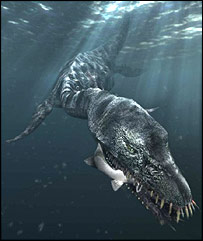
Copyright © 2003 BBC Science News
|
|
Previous reported sightings of the beast led to speculation that it might be a plesiosaur, a marine reptile which died out with the dinosaurs. The team was convinced that such an animal could have survived in the cold waters of Loch Ness, despite the normal preference of marine reptiles for sub-tropical waters.
The researchers looked at the habits of modern marine reptiles, such as crocodiles and leatherback turtles, to try to work out how a plesiosaur might have behaved. They hoped the instruments aboard their search boat would pick up the air in Nessie’s lungs as it reflected a distorted signal back to the sonar sensors.
|
The team did find a buoy moored several metres below the surface as a test for the equipment, but, in the end, no Loch Ness monster.”
[Full Story]
“Bizarre Lost City vent is truly ancient”
July 28, 2003, ABC News in Science, Australia: “The Lost City, a bizarre hydrothermal vent at the bottom of the Atlantic Ocean, has been active for at least 30,000 years, scientists have been surprised to discover.
|
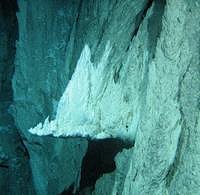
Copyright © 2003 ABC News in Science
|
|
Insights into the chemical process that build these towering chimney-like structures above the vent suggest that systems like it could be active for hundreds of thousands – and possibly millions – of years, according to a report in the journal, Science.
Carbon dating of the 30 or so structures – some of which are no longer active, and therefore have ceased to grow – show that ‘many of the sediments sampled to date were deposited just before the last glacial maximum 20,000 years ago,’ wrote the team led by Dr Gretchen Früh-Green of the Swiss Federal Institute of Technology in Zurich.
|
The Lost City was first discovered by chance in December 2000 during studies of a giant seafloor mountain known as the Atlantis Massif, in the mid-Atlantic.”
[Full Story]
“Portrait of a doomed Sea”
July 28, 2003, ESA News, France: “Earth’s youngest desert is shown in this July MERIS satellite image of the Aral Sea in Central Asia.
|
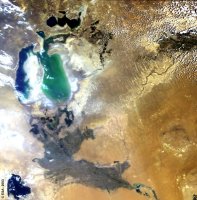
Copyright © 2003 ESA News, France
|
|
Once the fourth largest lake in the world, over the last 40 years the Aral Sea has evaporated back to half its original surface area and a quarter its initial volume, leaving a 40,000 square kilometre zone of dry white-coloured salt terrain now called the Aralkum Desert.
As its water level has dropped 13 metres since the 1960s the Sea has actually split into two – the larger horseshoe-shaped body of water and a smaller almost unconnected lake a little to its north.
|
This Small Aral Sea is the focus of international preservation efforts, but the Large Aral Sea has been judged beyond saving (the shallowness of its eastern section is clear in the image). It is expected to dry out completely by 2020.”
[Full Story]
“Loch Ness Sea Monster Fossil a Hoax, Say Scientists”
July 29, 2003, National Geographic News, USA: “The world’s favorite monster stole the headlines again this month, when the remains of a giant sea creature were discovered in Scotland’s Loch Ness. But instead of hailing the find as possible evidence of the monster’s existence, scientists now think it a hoax.
The fossil belonged to a plesiosaur, a fearsome predator that ruled the seas between 200 and 65 million years ago. Measuring 35 feet (11 meters) head to tail, with a long, serpentine neck, the reptile eventually died out with the dinosaurs.
Or did it? Many people believe it alive and well, if rather shy, having sought refuge in Scotland’s largest freshwater loch. These days it goes by the name of Nessie, the Loch Ness monster.”
[Full Story]
“Hydrothermal Vents May Persist Millions Of
Years Incubating Life”
July 29, 2003, Space Daily, USA: “The staying power of seafloor hydrothermal vent systems like the bizarre Lost City vent field is one reason they also may have been incubators of Earth’s earliest life, scientists report in a paper published in the July 25 issue of Science.
|
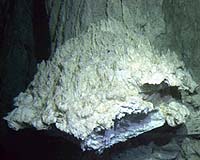
Copyright © 2003 Space Daily
|
|
Discovered just 2-1/2 years ago during a National Science Foundation-funded expedition in the mid-Atlantic Ocean, Lost City has the tallest vents ever seen – the 18-story behemoth at the site dwarfs most vents elsewhere by at least 100 feet.
Water is circulated through the vent field by heat from serpentinization, a chemical reaction between seawater and the mantle rock on which Lost City sits, rather than by heat from volcanic activity or magma, responsible for driving hydrothermal venting at sites scientists have been studying since the early 1970s.
|
If hydrothermal venting can occur without volcanism, it greatly increases the places on the seafloor of early Earth where microbial life could have started. It also means explorers may have more places than previously thought to look for microbial life in the universe.”
[Full Story]
“Mysteries of a sunken city coming to light”
July 30, 2003, NTV/MSNBC, Turkey: “The local legend of the sunken city is that it was inundated under the waters of Lake Köycegiz after an earthquake.
Archaeologists have begun underwater excavations at a site in the province of Mugla known as the “Sunken City”, the location of the healing waters of the Sultaniye Spas on Lake Köycegiz.
The head of the archaeological team, Professor Cengiz Isik, said that last year mapping of the sacred sanctuary of the Goddess Heto (Sultaniye Spa) had been completed and that now the excavations had begun.”
[Full Story]
“Incubator of Life Discovered at Ocean Bottom”
July 30, 2003, Pravda, Russia: “About two years ago a deep-water hydrothermal system was discovered. As it turned out later, the system existed for 30 thousand years already. Researchers say that similar systems probably existed on the Earth and on other planets for millions of years and even could become incubators of life.
A rocky column of minerals and microorganisms called the Lost City is situated at the depth of 2,500 meters below the Atlantic Ocean surface. The column is 55 meters high; it is higher than any other hydrothermal system. Below, under its structure, water is going through the cracked Earth crust.
The mineral serpentine is formed as a result of chemical reaction; this process also emits heat. Water warmed and enriched with minerals gets back to the ocean; on its way back the water rebuilds the unique structure of the Lost City.”
[Full Story]
“Mysteries of a ‘Sunken City’ coming to life”
July 30, 2003, NTV-MSNBC, Turkey: “Archaeologists have begun underwater excavations at a site in the province of Mugla known as the ‘Sunken City’, the location of the healing waters of the Sultaniye Spas on Lake Köycegiz.
The head of the archaeological team, Professor Cengiz Isik, said that last year mapping of the sacred sanctuary of the Goddess Heto (Sultaniye Spa) had been completed and that now the excavations had begun
Isik said that the Sultaniye Spas were an archaic health centre and that their excavations would uncover its past and make a contribution to tourism”
[Full Story]
“Soldiers Claim to See Mysterious Lake Monsters in China”
July 31, 2003, People’s Daily, China: “A group of soldiers claims to have spotted China’s “Loch Ness Monster”, the second sighting of the mysterious animal in Tianchi Lake in northeast China’s Jilin Province in less than a month.
Yu Wenhe, deputy political commissar of the People’s Liberation Army unit stationed in Yanbian, told Xinhua over the telephone that a blackish green animal was first spotted at 10:00 a.m. Wednesday in Tianchi Lake.
Yu said more than 10 servicemen were visiting the lake with him when they saw something unusual moving on the surface of the water.”
[Full Story]
“Believers in the lost Ark: Treating myth as fact misunderstands the meaning of religion”
August 09, 2003, The Guardian, UK: “The explorer who discovered the Titanic beneath the Atlantic in 1985 is setting out on another underwater expedition to document Noah’s flood. The Black Sea was originally a freshwater lake that in ancient times became inundated by the salty Mediterranean. Robert Ballard believes that this was a cataclysmic event that occurred about 7,500 years ago, and was possibly the deluge described in the Bible.
Ballard’s critics are sceptical: they argue that the infiltration of the Black Sea was a gradual process that occurred much earlier and over a long period of time. They accuse Ballard of using Noah to sex up his material for maximum publicity.
Christian fundamentalists will expect great things of Ballard’s expedition. American creationists, who believe that the book of Genesis gives a scientifically accurate account of the origins of life, have long discussed Noah’s flood. Some have even led archaeological expeditions to Mount Ararat in Turkey, in the hope of unearthing the Ark, and proving the literal truth of scripture once and for all.”
[Full Story]
“Maui researchers studying life near undersea volcano”
August 11, 2003, Honolulu Advertiser, Hawaii: “Scientists using supercomputers to study the bacteria that thrive in Hawai’i’s inhospitable undersea world say mapping the genetic patterns of the micro-organisms could lead to a number of medical breakthroughs, including possibly creation of a blood substitute.
Researchers at the Maui High Performance Computing Center have received a grant from IBM Corp. to study the organisms found in the acidic, heated waters surrounding the submerged Loihi active volcano, a formation in 3,000-foot waters about 20 miles off the Big Island.
The research builds on work unveiled two years ago that sequenced the genome of a rare bacteria collected from the volcano’s vent, a deep-sea habitat similar to the primordial pools from which life began 3.5 billion years ago.”
[Full Story]
“Search for lost river throws up 300 AD site in Haryana”
August 13, 2003, Indian Express, India: “The Archaeological Survey of India’s (ASI), Rs-8-crore search for the mythical Saraswati has thrown up an exciting find at the foothills of the Shivalik — and a new controversy.
Extensive excavation in the last seven months at Adi Badri site, 40 km north of the Yamunanagar district in Haryana, has yielded a 300 AD Kushan site — and speculation that this may be the spot where the river had originated. The finds at the 200-foot-high Intowali site (ABR-II) include a monastery, Buddha statue, pottery, pieces of carved slabs, a meditation hall, verandah, an entrance, and several artefacts.
Archaeologists say now there is enough evidence to prove that this was one of the major areas of inhabitation on the banks of the Saraswati that once flourished, and then disappeared without a trace.”
[Full Story]
RECAP: On Saturday, January 19, 2002, BBC News Online told of a ‘lost city’ that had recently been discovered in about 120 feet of underwater in the Gulf of Khambhat (Cambay) off the western coast of Gujarat, in India. It was found completely by chance by marine scientists from the Indian National Institute of Ocean Technology, (NIOT), who were conducting a water pollution survey of the area. Oceanographers from NIOT told the BBC that they had discovered archæological remains which could be over 9,000 years old.
Further studies using satellite photos of the area, along with side-scan sonar and sub-bottom profiling, have shown evidence of the course of a river, now believed to be the ‘once-thought-mythical’ Saraswati, extending out into the Gulf of Cambay where they have identified what seem to be the remains two ‘urban settlements’ now underwater. Each of these ‘urban settlements’ are reported to be about the size of Manhatten, and more information on this discovery can be found on our 2002 Underwater Discoveries page.
“Ancient polar lake could erupt”
August 14, 2003, Billings Gazette, USA: “If Russian researchers in Antarctica succeed in drilling through the final 120 meters of nearly 4 kilometers of ice to reach an ancient, unexplored lake underneath, scientists at NASA warn that the hole could cause a dangerous eruption that spews water thousands of feet into the air.
The American scientists speculate that the water in pristine Lake Vostok, filled with gases and pressurized under tons and tons of ice, would act like a carbonated drink in a can that’s shaken and then popped open.
Their concern is that the lake water, which has not been exposed to Earth’s atmosphere in as many as 15 million years, might become contaminated with microbes and chemicals from the surface. And unsuspecting researchers could get injured by an icy blast from the lake.”
[Full Story]
“Deep-sea camera offers a unique glimpse of ancient history”
August 14, 2003, The Providence Journal, USA: “Live and in video color: a deep-sea robot called Hercules, exploring an ancient Roman shipwreck in the Mediterranean.
At the helm of this undersea excavation, explorer and oceanographer Robert D. Ballard, who discovered the Titanic’s watery grave.
A handpicked audience at the University of Rhode Island’s Coastal Research Institute enjoyed a private peek yesterday at Ballard’s ongoing 2003 expedition: a 41-day, world-first archaeological excavation of shipwrecks in the Black Sea and the eastern Mediterranean.”
[Full Story]
“Ancient superflood brought climate chaos”
August 15, 2003, ABC News in Science, Australia: “A catastrophic ‘superflood’ following the rupture of a massive glacier-dammed lake in Canada at the end of the Ice Age probably plunged the world into centuries of climatic chaos.
That single event was likely responsible for the most dramatic climate change of the last 10,000 years, according to a report by a Canadian team led by Professor Garry Clarke, a geophysicist at the University of British Columbia in Vancouver, which appears today in the journal Science.
The ‘superflood’ was enough to alter ocean circulation in the Northern Hemisphere: analysis of ice cores taken in Greenland reveal that for the next 200 years or so, the mean temperature dropped by 5°C, snow accumulation decreased sharply and forest fires became more frequent.”
[Full Story]
“Drilling Into Frozen Lake Vostok Debated”
August 19, 2003, Discovery Channel News, USA: “An ancient, ice-capped lake in Antarctica that has drawn keen interest from scientists studying extreme environments for new forms of life is pressurized like a can of fizzy soda and could become contaminated if proper drilling methods aren’t adopted, researchers warn.
Lake Vostok is located about 2.5 miles beneath the East Antarctic Ice Sheet. The lake is one of 70 bodies of water that have been cut off from the atmosphere since ice covered the polar regions more than 15 million years ago.
Scientists believe Lake Vostok may be home to undiscovered life forms, an area of study that has key implications in the search for life beyond Earth.”
[Full Story]
“Ancient Antarctic lake may erupt if drilled”
August 20, 2003, ABC News in Science, Australia: “Plans to drill into an ancient lake deep under ice in Antarctica may lead it to erupt in a massive geyser-like explosion, scientists have warned.
|
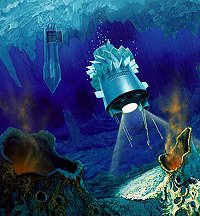
Copyright © 2003 ABC News in Science, Australia
|
|
Lake Vostok in Antarctica has spent 15 million years under 4 km of ice, its waters sealed off from air and light for all that time under the tremendous pressure of the continental ice sheet.
The 14,000 km2 lake, about 1,300 km from the South Pole, is one of the world’s largest and scientists believe that it could offer unique research opportunities.
But despite opposition from environmentalists who fear drilling into the lake could destroy it, Russian scientists plan to cut through the ice until they come close to the surface of the lake.
|
U.S. scientists are also interested in drilling into the lake to see if any life forms can exist there, a finding which could lend weight to theories that life exists in other extreme environments such as other planets.”
[Full Story]
“Twelve ancient urns found at the bottom of the sea in Rhodes”
September 01, 2003, Macedonian Press Agency, Greece: “Twelve ancient urns of different sizes were discovered by a diver at the sea region of Akromolio, in the southeastern Aegean island of Rhodes.
The urns were found at the bottom of the sea at a depth of 15 meters, during a search for a missing swimmer and were collected under the supervision of the Rhodes Port Authority.”
“European scientists look back 750,000 years
through Antarctic ice core”
September 08, 2003, Cordis, Luxembourg: “A 3,200 metre ice core removed from the Antarctic and shipped back to labs across Europe will reveal information about what conditions were like on Earth up to 750,000 years ago.
The sample, the oldest ever retrieved, was removed from the Dome Concordia region by scientists working on the European project for ice coring in Antarctica (EPICA). The long term initiative has been running for over seven years, and is currently funded under the energy, environment and sustainable development section of the Fifth Framework Programme.
Researchers working in laboratories in each of the ten countries involved in the project will use oxygen and hydrogen isotopes trapped in the ice to work out what the temperature was when it formed. Periods of global warming will be revealed through the presence of high levels of carbon dioxide and methane.”
[Full Story]
“Archaeologists link ship to Blackbeard”
September 08, 2003, Billings Gazette, USA: “Archaeologists are investigating whether a burned shipwreck off the North Carolina coast is the remains of the last ship captured by the pirate Blackbeard.
A nonprofit marine archaeology and exploration team announced in July that it had found the shipwreck in Ocracoke Inlet, along the state’s barrier islands.
Officials with Surface Interval Diving Company have said the wreckage could also be that of a Civil War-era vessel burned by retreating Confederate officers in 1861.”
[Full Story]
“Oldest ever ice core promises climate revelations”
September 08, 2003, New Scientist, UK: “An ice core recently shipped from Antarctica has yielded its first, eagerly awaited results. The tests confirm that the 3200-metre core dates back at least 750,000 years, making the ice the oldest continuous core ever retrieved.
Gases and particles trapped in the layers of an ice core provide information about the Earth’s climate and atmosphere. Oxygen and hydrogen isotopes reveal the temperature when the ice formed, for example, while high carbon dioxide and methane levels indicate periods of global warming.
A group of research teams called the European Project for Ice Coring in Antarctica (EPICA) has been drilling cores at two sites – Dome Concordia in the Pacific sector and Dronning Maud Land in the Atlantic sector.”
[Full Story]
“Ancient fish trap discovered”
September 10, 2003, Juneau Empire, Alaska: “While walking along the lower Chilkoot River just over a year ago, a Lutak resident noticed a pattern in some wooden stakes embedded on the bank.
Some two dozen partially eroded posts of similar width and height were spaced almost strategically.
The resident contacted local archaeologist Tom Prang, now working on contract for the Chilkoot River Corridor Working Group, who determined the stakes were likely left over from a Native village that once thrived at the Chilkoot.”
[Full Story]
“Undersea Stone Age site found”
September 11, 2003, BBC News Online, UK: “A team of scuba-diving archaeologists have discovered an undersea settlement that could be 10,000 years old.
|
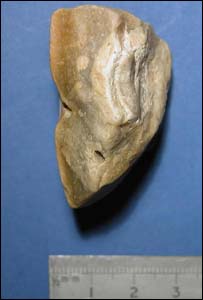
Copyright © 2003 BBC News Online, UK
|
|
The divers were honing their skills in preparation for a more detailed search further away from Tyneside. But they found what is believed to be the country’s second submerged Stone Age development, while practising in the North Sea off Tynemouth.
Another slightly more recent site, still from the Mesolithic era, was also found on the seabed nearby. The settlements came to light when Dr Penny Spikins of Newcastle University noticed some flints on the seabed, which she instantly recognised as being significant.
Dr Spikins, leader of the international research team behind the Submerged Prehistoric Landscapes Project, said:
|
‘I was learning to scuba dive and was in the middle of a training session in the sea when I noticed lots of pieces of flint beneath me on the sea bed. To the average person they would seem like ordinary stones you would find on the beach, but to a specialist they were something very exciting indeed.’“
[Full Story]
“Accidental find unearths Stone Age settlement
beneath the North Sea”
September 12, 2003, The Scotsman, Scotland: “A TEAM of marine archaeologists has chanced upon an undersea settlement that could be 10,000 years old.
They found what is believed to be the country’s second submerged Stone Age development while on a practice dive in the North Sea near the mouth of the Tyne. Another, slightly more recent site, still from the Mesolithic period, was found on the seabed nearby.
Dr Penny Spikins, of Newcastle University, the leader of the multinational research team behind the Submerged Prehistoric Landscapes Project, made the initial discovery. She said: ‘I was learning to scuba dive and was in the middle of a training session when I noticed lots of pieces of flint beneath me on the sea bed.
To the average person they would seem like ordinary stones you would find on the beach, but to a specialist they were something very exciting indeed.'”
[Full Story]
“Prehistoric settlements found under North sea”
September 12, 2003, The Guardian, UK: “To the untutored eye, they appear like the anonymous pebbles fringing any shoreline. But the small cluster of rocks found eight metres (26ft) under the North sea were hailed yesterday as a stepping stone to the little-known world of Mesolithic people, perhaps shedding fresh light on a “prehistoric Atlantis” beneath the waves.
Unveiled yesterday by a team from the University of Newcastle upon Tyne the artifacts, including tools and arrowheads, have pinpointed the locations of two settlements of hunter-gatherers from the middle stone age.
The secret locations, more than 500 metres off the Tyneside coast, were submerged 10,000 years ago as sea levels rose after the last ice age. They could be the earliest underwater archaeological sites in the UK.”
[Full Story]
“Finding Nemo 1: Originating Species”
September 13, 2003, Astrobiology Magazine, USA: “TThe study of biodiversity and astrobiology share the common thread of viewing the planet as a whole and attempting to see its future by examining its past.
The present moment in history has been characterized as the first time in which one species– humans– are in one way or another ‘responsible’ for the entire biosphere: changing it, maintaining it, and of course, possibly extinguishing it.
According to the World Wildlife Fund, the Earth is losing species at a rate not seen for 65 million years, since the extinction of the dinosaurs.”
[Full Story]
“Finding Nemo 2: Creatures With No Name”
September 14, 2003, Astrobiology Magazine, USA: “To explore deep sea habitats and biodiversity in the Tasman Sea, a joint Australian-New Zealand research voyage carried leading Australian, New Zealand and other international scientists to uncover new marine species and habitats.
The NORFANZ research voyage explored deep sea habitats around seamounts and abyssal plains around Lord Howe and Norfolk Islands through to northern New Zealand.
The voyage collected biodiversity samples, DNA tissue samples, seabed habitat data, photographs and video on seamounts at depths between 200 meters and 1.2 kilometers, and surveyed free-swimming animals that live in the water masses above and around these seamounts. “
[Full Story]
“Finding Nemo 5: Diving The Abyss”
September 20, 2003, Astrobiology Magazine, USA: “We arrived at Lord Howe Island at about 08.30 hours. The is no harbour here. With a vessel draft of nearly 7m it took a couple of hours of careful and slow steaming through shallow reefs to arrive at a safe anchorage.
Ships master, Andrew Leachman, officers and crew all did a skilled job that they made look easy. We anchored off Ned’s Beach, which was sheltered but still rolling with the ocean swell as it moved over the shallow water.
Most of the morning was spent making arrangements to transfer scientists, including arranging customs clearance and pick up from the vessel. Procedures ran smoothly without mishap. We said goodbye to several colleagues and welcomed aboard their replacements.”
[Full Story]
“Britain’s drowned landscapes: When the UK was linked
to Europe by plains and forests”
September 21, 2003, The Observer, UK: “Herds of reindeer and horses migrated across its plains, huge forests covered much of the countryside and men and women made their homes by rivers and lakes.
Then came the deluge, and this ancient Arcadia – which stretched across the North Sea, and covered the Channel – was inundated. All signs of human and animal activity were covered by several hundred feet of water. Only the occasional stone tool, bone harpoon and mammoth tusk, trawled from the sea bed by fishing boats, has provided reminders of this lost world’s existence.
But the drowned lands of the North Sea and Channel may soon be revealed by British scientists using a revolutionary underwater scanning technique that can create sea-bed maps and images as accurate and detailed as those made of dry land. In the process, the idea of Britain as an island kingdom will be challenged by researchers.”
[Full Story]
“Rich fossil haul from ancient beaver pond”
September 25, 2003, ABC News in Science, Australia: “A prehistoric beaver pond unearthed in freezing northern Canada has proved to be a treasure trove of fossilised plants and animals – and provides some stark new insights into the powerful impact that climate change can have on living things.
Dr Richard Tedford, of the American Museum of Natural History and Dr Richard Harington, of the Canadian Museum of Nature, report their findings in today’s issue of the journal Nature.
The researchers report that the pond environment has been preserved in rich detail – right down to wood featuring beaver teeth-cuts – in a deep peat deposit on chilly Ellesmere Island in Canada. It was laid down in the Early Pliocene epoch, some four to five million years ago, they say.”
[Full Story]
“Finding Nemo 8: Ocean Enigmas”
September 27, 2003, Astrobiology Magazine, USA: “It’s early morning and the ratcatcher is down. Last night was a mix of beam trawls and ratcatchers and one trawl with badly tangled doors. The crew efficiently untangled the knot and trawling continued.
One catch brought in many redbait (Emmelichthys nitidis), a small fish in the bonnetmouth family (Emmelichthyidae). The bonnet name refers to their expandable jaws. These fish feed in large schools like anchovies.
Everybody is working very hard. It is 12 hour shifts, seven days a week. The crew work from 12 to 12 and have all the work associated with running and maintaining the ship, deploying nets and changing between sampling gear types.”
[Full Story]
“The search for Atlantis ‘ends at Ayia Napa'”
September 28, 2003, The Daily Telegraph, UK: “It may be the answer generations of experts on the ancient world have been looking for. New research claims that the fabled ancient civilisation of Atlantis is located close to Cyprus.
|
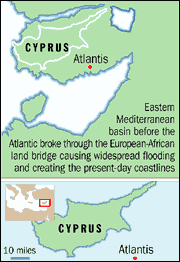
Copyright © 2003 The Daily Telegraph
|
|
After nearly 10 years of research using ocean mapping technology and accounts from ancient texts, an American explorer says he has evidence that Atlantis lies beneath the deep blue waters off the southern tip of the island.
Robert Sarmast, a self-proclaimed mythologist and expert on the ancient world, makes this claim in his book, Discovery of Atlantis – The Startling Case for the Island of Cyprus, published last week in America by Origin Press.
Mr Sarmast uses maps to show the location of archaeological remains on a sunken strip of land just off the south coast of Cyprus, which he says is Atlantis.
|
Mr Sarmast said at his home in California last week: “This is going to rewrite the history books. We are set to make the biggest archaeological discovery of all time.’“
[Full Story]
“Ancient Stone Age Sites Found Under the Sea”
September 28, 2003, The Media Drome, UK: “A team of researchers scuba diving near the Tynemouth coast in the North Sea stumbled upon two large Stone Age settlements dating back to the Mesolithic era. The first site found 500 yards out to sea is approximately 10,000 years old, while the second site, about 100 yards further out, dates back about 8,500 years.
Mesolithic people, who were hunter-gatherers, lived during the Middle Stone Age. It’s the first evidence of these underwater sites since fisherman discovered a Mesolithic antler harpoon in the British North Sea about 100 years ago.
Both settlements were eventually submerged under the seabed following the last Ice Age.”
[Full Story]
“Prehistoric Sea Creature Discovered”
September 29, 2003, Discovery Channel News, USA: “British and Canadian scientists have discovered the unique fossil of a prehistoric sea creature with eyes raised like “twin towers,” they reported in the latest issue of the journal Science.
Living on the sea floor some 400 million years ago in what is now Morocco, the hard shelled, many legged animal is the only known complete specimen of the phacopoid trilobite Erbenochile.
Trilobites were arthropods with hard, articulated external skeletons that appeared during the Cambrian period (570-505 million years ago) and flourished for 300 million years. Among the most active animals in the sea, they ran around the floors of shallow seas and occasionally burrowed in the sediment.”
[Full Story]
“Finding Nemo 9: Revolution Underwater”
October 03, 2003, Astrobiology Magazine, USA: “Big afternoon and evening yesterday. Returning to the area of the million brittle stars, a Sherman sled, an orange roughy trawl and a beam trawl were sent down at different depths. The sled was on the slope, at around 700 metres (170 m deeper than yesterday’s live brittle star aggregations). It seemed to be where all the shells and other hard remains slid down to when they die.
There were very few live animals in the shell gravel collected in this trawl. The next two nets were shallower and brought up more interesting creatures, again mainly invertebrates. It took the night invertebrate crew another six hours to sort this catch, identifying more than 80 species. One of the weirdest was a large sponge that looked like a cross between a bush and a large whale bone. Crabs, shrimps and serpent stars were living in its nooks and crannies.
Fish catches have also been interesting, including a long-finned gemfish (Rexea antefurcata), a prickly shark, a leopard chimaera (Chimaera panthera), red dory (Cyttopsis roseus), mirror dory (Zenopsis nebulosus) and New Zealand frostfish (Lepidopus caudatus).”
[Full Story]
“Discovery of Atlantis: The Startling Case
for the Island of Cyprus”
October 07, 2003, Pravda, Russia: “When Plato first presented the story of Atlantis in two of his most famous dialogues, he may have unwittingly launched one of the greatest mysteries of all time – especially for those who have refused to take his account literally.
Robert Sarmast’s new book shows that Plato’s description of Atlantis was not a figment of his imagination, not just a philosopher’s allegory or literary ornament, and can be taken at face value. Discovery of Atlantis attempts to prove that Plato’s richly detailed story actually referenced something very real: a sunken landmass, a majestic city, a great people, and a civilization of extreme antiquity. And if Plato is to be taken literally, that civilization existed on the island of Cyprus and especially on the submerged land mass just south of Cyprus.
The basis for this bold claim are the nearly 50 physical clues that Plato provides in his famous dialogues Critias and Timaeus?the original accounts of the story of Atlantis. In essence, Discovery of Atlantis shows that Cyprus and its vicinity are a near – perfect match with all the factual clues in Plato’s account.”
[Full Story]
“Finding Nemo 10: Weird Adaptations”
October 07, 2003, Astrobiology Magazine, USA: “To explore deep sea habitats and biodiversity in the Tasman Sea, a joint Australian-New Zealand research voyage carried leading Australian, New Zealand and other international scientists to uncover new marine species and habitats.
NORFANZ research voyage explored deep sea habitats around seamounts and abyssal plains around Lord Howe and Norfolk Islands through to northern New Zealand. The voyage collected biodiversity samples, DNA tissue samples, seabed habitat data, photographs and video on seamounts at depths between 200 meters and 1.2 kilometers, and surveyed free-swimming animals that live in the water masses above and around these seamounts.
Australia’s National Oceans Office – the body responsible for developing and implementing Australia’s Oceans Policy – and the New Zealand Ministry of Fisheries supported the four-week voyage between 10 May and 8 June.”
[Full Story]
“Sonar whale deaths linked to the bends
for the Island of Cyprus”
October 09, 2003, The Age, Australia: “Military sonar may be to blame for catastrophic deaths of whales, prompting the deep-diving mammals to ascend so quickly that, like divers who decompress too fast, they suffer a fatal attack of “the bends”, a study has found.
Powerful naval sonar has already been implicated in the stranding of whales and dolphins, perhaps by disorienting them, but this research is the first to yield clinical evidence as to exactly how the animals could be affected.”
[Full Story]
“Something fishy about ancients’ shift to meat”
October 12, 2003, IOL/Sunday Argus, South Africa: “About 6 000 years ago, people living in what is now Britain, stopped eating fish and shifted to cattle, sheep, pigs and goats in an abrupt and mysterious transformation that may offer new insights into the complex reasons why ancient peoples periodically changed their way of life.
The dietary switch occurred as part of a Neolithic Revolution, a set of radical pre-Bronze Age changes that included the introduction of domesticated plants and animals, development of pottery and a distinctive type of ritual burial widespread in mainland Europe.
‘All this stuff appears, but why did people suddenly stop doing the things they did before?” asked archaeologist Michael Richards, of the University of Bradford. “In most Old World areas, it was much more gradual. Why not in Britain? This is the big question.’“
[Full Story]
“Cayce Group Hunts Atlantis”
October 17, 2003, Phenomena Magazine, USA: “The Association for Research and Enlightenment (ARE) – also known as the ‘Edgar Cayce group’ – have released the latest edition of their E-mag ANCIENT MYSTERIES.
This edition is particularly devoted to the group’s search for Atlantis – one of the key parts of Edgar Cayce’s writings.
There are numerous articles on possible Atlantis sites to read in the E-mag, from Yonaguni to Bimini and the ubiquitous ‘Paws of the Sphinx’.”
[Full Story]
“Bone belonged to ancient 6ft newt”
October 18, 2003, The Daily Telegraph, UK: “A piece of skull found embedded in a rock about to be swept out to sea has been confirmed as that of a 300 million-year-old previously unknown giant amphibian.
Dave Martill, an authority on dinosaurs, made the discovery while walking with his sons along a beach at Whitley Bay, North Tynside.
As he stepped over an 18in block of ironstone he noticed what appeared to be a piece of protruding bone.”
[Full Story]
“Explorers on the trail of Lost City of Atlantis”
October 27, 2003, The Daily Telegraph, UK: “An expedition to the Strait of Gibraltar may solve one of the world’s greatest mysteries, reports Roger Highfield.
For more than two millennia, many of the world’s greatest adventurers, explorers and thinkers have sought the fabled Lost City of Atlantis.
Next month, an expedition to hunt for its remains among submerged Gibraltarian islands will be unveiled at the Royal Geographical Society, London, by a renowned geologist, Prof Jacques Collina-Girard, and the leaders of the Titanic expeditions.”
[Full Story]
“Hunt for Lost City of Atlantis
“
October 30, 2003, BBC News Online, UK: “A team of experts believes it could be close to unravelling the millennia-old myth of the Lost City of Atlantis and is launching an expedition to the seas west of Gibraltar to test its theory.
The team is led by eminent pre-historian Professor Jacques Collina-Girard, aided by the two men who led the expeditions to the Titanic.
They believe that using a combination of literary pointers and geological evidence they have pinned the lost city’s location to just west of the Straits of Gibraltar, on a submerged mud shoal now known as Spartel Island.”
[Full Story]
“Romans Rise from the Waters”
November 01, 2003, IPS, Italy: “After 15 years of pause, archaeological excavations have been resumed in Serbia, an area rich with remains of ancient Roman sites along the Danube and Sava rivers.
The most attractive to local public was the first ever underwater expedition in the Danube, the natural border between Serbia and Romania.
It confirmed the existence of the Trajan Bridge, which once had a 1070-metre span across the river between what are today the towns of Kladovo and the Romanian port Turnu Severin some 170 km east of Belgrade.”
[Full Story]
“Melting polar ice shelves linked to warmer seas”
November 03, 2003, New Zealand Herald, New Zealand: “An Antarctic ice shelf the size of Scotland is rapidly disintegrating due to warmer seas, according to the second study in two days to show a dramatic thinning of polar ice.
Scientists believe that the Larsen ice shelf on the Antarctic Peninsula may disappear altogether within 70 years, and even earlier if warming trends continue.
Although the ice shelf itself will not raise sea levels – it is already floating on the ocean – scientists say its loss may trigger a catastrophic release of ice on the peninsula’s mainland, causing global sea levels to rise up to 1m.”
[Full Story]
“What Controls the Global Thermohaline Circulation?”
November 12, 2003, CO2 Science Magazine, USA: “Many people fear – or at least claim they do – that global warming will lead to enhanced precipitation in high northern latitudes, which will lead to augmented freshwater runoff to the North Atlantic Ocean, which will lead to a precipitous decline in North Atlantic Deep Water formation, which will produce a swift reduction in the global ocean’s thermohaline circulation, which will shut down the Gulf Stream and bring cold times to Europe
[see Rapid Climate Change in our Subject Index]. Are their worries justified?
In exploring this hypothesis, the authors used ‘a coupled model which comprises an ocean general circulation model, a dynamic-thermodynamic sea ice model and an energy-moisture balance atmospheric model’ to examine ‘the effect of meridional moisture transport in the Southern Hemisphere mid-latitudes on the meridional overturning circulation (MOC) and heat transport in the Atlantic.’
The authors purport to show that ‘the Atlantic MOC, northward oceanic heat transport, and the associated air-sea heat flux anomalies are all proportional to the southward moisture transport from subtropical to subpolar regions in the Southern Hemisphere.’“
[Full Story]
“Archaeologists find the traces of an ancient Persian fleet”
November 15, 2003, Kathimerini, Greece: “Significant discoveries that may point to the location of a sunken fleet led by the Persian general Mardonio have been made by an underwater archaeological team working at the eastern side of the Mt Athos peninsula in October, organized by the Underwater Antiquities Ephorate in cooperation with the Canadian Archaeological Institute and the Greek Center for Marine Research.
Particularly encouraging was the discovery of a metal object identified as the point to the bottom of a spear, a rare find in the sea. The exploration, led by the ephorate’s director Ekaterini Dellaporta and Professor Shelley Wachsmann of Texas University, provided many positive results that will ensure its continuation next season with permission from the Culture Ministry.
The goal was to discover the Persian fleet of some 300 ships that sank during a storm near Mt Athos during Darius’ first attempt to invade Greece in 493 BC.”
[Full Story]
“Extinct sea ‘reappears’ in West Texas, complete with shrimp”
November 15, 2003, WestTexas.com, USA: “Interstates 10 and 20 form a wishbone in the heart of West Texas. Though the area is a desert now, scientists say the Permian Sea once covered the region. Then, a mere 225 million years ago, the sea began to retreat into what is now the Gulf of Mexico. What was left eventually dried up.
At least that’s what scientists say. But what do they know? Bart and Pasty Reid of tiny Imperial, just over an hour southwest of Midland, have a different theory. Their town is on Highway 11 at the heart of the West Texas wishbone, the heart of what was once the Permian Sea. The Reids insist they have found the sea and that it still exists. Like a fugitive from the FBI, it went underground.
They are proving their theory, too. Pumping briny water from the Cenozoic Pecos Aquifer, they are using it to raise 64 acres of Pacific white sea shrimp right in the middle of the desert.”
[Full Story]
“Ancient ice may hold a few frosty secrets”
November 17, 2003, IOL, South Africa: “Scientists in Germany are handling the oldest ice that has ever been unearthed in what is hoped will provide important information on climate change.
Around 120 chunks of ice, each around half a metre long and 10 centimetres in diameter, are being examined by the Alfred Wegener Institute for Polar and Marine Research (AWI) in Bremerhaven.
The ice cores, which were drilled during last winter in the Antarctic, are up to 900 000 years old.”
[Full Story]
“Europa and Undersea Divers”
November 18, 2003, Astrobiology Magazine, USA: “SETI Institute astrobiologist Kevin Hand describes the universe as a work of art and science as the brush strokes that create it. The analogy emerges as Hand grasps for a connection between the many endeavors in which he is involved.
The young scientist’s life itself is much like a broad and vividly painted canvas, filled with a richness of experience that belies his youth.
Just this summer, the Stanford Ph.D. student–who is not yet thirty–has: traveled across rural Africa this summer with an educational non-profit he established; attended a special summer program in marine biology where he learned hands-on laboratory techniques; and joined research expeditions to the Atlantic and Pacific Oceans, where he dove to the sea floor in a submersible to explore the exotic hydrothermal vent systems that offer clues to life’s origins.”
[Full Story]
“Japanese researchers cast doubt on El Nino myths”
November 18, 2003, The Japan Times, Japan: “A group of researchers in Japan claims to have overturned the common belief that El Nino-like phenomena only take place in tropical regions.
The group said Monday it has found that warm water in the North Pacific heats up the atmosphere in winter and causes large-scale air movements.
By analyzing a database of ocean surface temperatures, wind speed and other elements dating back 45 years, the team of the government-affiliated Frontier Research System for Global Change found that air above the seas off northeastern Japan was heated by warm seawater in winter. The flow of warm air then affects water in other parts of the North Pacific.”
[Full Story]
“Excavation of Confederate submarine complete”
November 22, 2003, The Sun News, USA: “The excavation of the Confederate submarine H.L. Hunley is complete, more than three years after the sub was raised from the Atlantic off the coast of Charleston.
Scientists this week finished removing sediment from the ballast tanks of the sub after recovering a coil of waterlogged rope.
They also recovered some tools from the crew compartment, which might indicate the crew had been making repairs the night the Hunley sank.”
[Full Story]
“Ghost fleet ‘shows Pisa was an ancient Venice'”
November 22, 2003, The Daily Telegraph, UK: “The chance discovery of a Roman “ghost fleet” buried in mud just outside Pisa has led experts to conclude that the city was built on a lagoon much like an early Venice.
Archaeologists believe that traces of a community dating back to a pre-Roman era, a sort of “Etruscan Venice”, may lie beneath the ships.
The end of the lagoon civilisation may also offer clues to the fate of modern Venice – the waterways were silted up by violent floods over a long period.”
[Full Story]
“Fate of possible Columbus ship emerging from stormy waters”
November 23, 2003, Archaeological Legacy Institute, USA: “Agreement may soon be reached among contending parties regarding the disposition of a Panamanian shipwreck that some identify as La Vizcaina, abandoned by Christopher Columbus on his fourth and final voyage in 1503.
According to Carlos Fitzgerald, National Director of Cultural Heritage of the Panamanian National Institute of Culture (INAC), a cooperative agreement for further research is expected between the Institute of Nautical Archaeology (INA) from Texas A&M University and Marine Investigations of the Isthmus (IMDI), a for-profit group that recovered the first artifacts from the wreck in 2001.
This agreement will clear the way toward initiation of a research program to investigate one of the earliest shipwrecks yet found in the Western Hemisphere from the period of European exploration.”
[Full Story]
“More Koryo Relics Found in Shipwreck Off Kunsan”
November 24, 2003, The Korea Times, South Korea: “A large number of celadon artifacts dating back to the Koryo Kingdom (918-1392) and utensils for seamen were found in the wreck of a sunken wooden cargo vessel that is believed to have been constructed during the 11th century and just discovered in the waters off Kunsan in North Cholla Province last month.
|
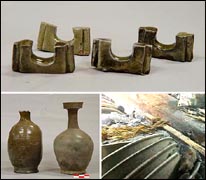
Copyright © 2003 The Korea Times
|
|
An exploration team from the National Maritime Museum announced yesterday that a total of 5,266 artifacts, including ceramic pottery items, bronze spoons and iron cauldrons, were pulled up, and the structure of the vessel was identified through an investigation conducted from Oct. 21 through Nov. 19. The vessel was discovered around Sibidongpado, a small archipelago about 30 kilometers west of Kunsan, after a fisherman reported to the Kunsan City government that he had found 622 ancient artifacts in his net.
|
The exploration team said the vessel had sunk upright, and wooden wedges and straw were placed between the celadon wares to prevent breakage.”
[Full Story]
“Atlantis Under Sahara?”
November 25, 2003, Phenomena Magazine, USA: “Archaeologist Dr. Carla Sage believes that Atlantis lies beneath the Sahara Desert. Before she is shouted down though, she points out that in the ancient accounts, the Mycenaean, Cretan and Egyptian civilizations all traded with Atlantis. The location of these civilizations suggests that Atlantis was not in the North Atlantic, as many believe, but in North Africa.
“Atlantis was clearly within easy trading distance of Troy and the other city states of the Mediterranean,” Dr Sage says. “I believe Atlantis was the capital of a vast North African empire with ports on the Gulf of Sidra.
[It] was destroyed, not by earthquake, floods or volcanoes, but by the steady march of desert sands that smothered the civilization.’“
[Full Story]
“17th century Javanese coins found in Thames mud”
December 1, 2003, The Guardian, UK: “Earlier this year a mudlark found what must have seemed a disappointing return for a morning spent scouring the mudbanks of the Thames: a fistful of coins, legally qualifying as treasure but of diabolical quality.
The salvagers, known as mudlarks, who patrol every twist and turn of the river and its banks at low tide, find masses of coins every year, mostly fallen from modern pockets, or obsolete English coins which are still very common.
These ones turned out to be extremely rare: the British Museum, which has one of the best coin collections in the world, only has six of them.”
[Full Story]
“New Hybrid Vehicle Will Reach Deepest Parts
of the World Ocean Floor”
December 9, 2003, NewsWise, USA: “For the first time since 1960, US scientists will be able to explore the deepest parts of the world’s oceans, up to seven miles below the surface, with a novel underwater vehicle capable of performing multiple tasks in extreme conditions.
Researchers at the Woods Hole Oceanographic Institution (WHOI) are developing a battery-powered underwater robot to enable scientists to explore the ocean’s most remote regions up to 11,000 meters (36,000-feet) deep.
The hybrid remotely operated vehicle, or HROV, will be able to operate in two modes: as an autonomous, or free-swimming, vehicle for wide area surveys, and as a tethered, or cabled, vehicle for close-up sampling and other tasks.”
[Full Story]
“Back when Indonesia was part of Australia … “
December 10, 2003, Sydney Morning Herald, Australia: “SHE was tall and strong and in her late 20s when she died about 18,000 years ago. Her teeth were not worn down, so she had probably enjoyed a diet of wallaby and other animals rather than chewing on tough plants.
Named after the limestone cave where she was found, Lemdubu Woman and her burial site provide a unique insight into life in the north of the continent during the last glacial maximum, when Australia was much colder and drier.
Today, Lemdubu Cave sits amid the dense rainforest of the Aru islands in Indonesia. But at the time the young woman died, sea levels were at their lowest because the ice sheets were at their greatest extent, and the Aru islands were part of a bigger Australian land mass, called Sahulland, that included New Guinea and Tasmania.”
[Full Story]
“Palaeontology: Creature from the shallows”
December 19, 2003, Nature, UK: “For over a century, palaeontologists have puzzled over a tiny fossil vertebrate, Palaeospondylus gunni Traquair.
First discovered in 1890, it is known only from a single site, a quarry in Caithness, Scotland, where paradoxically it is extremely abundant.
Early workers found its anatomy so baffling that they created special Greek names for its structures. Re-examination of the 400-million-year-old fossil with the latest techniques has uncovered its secret.”
[Full Story]
“Precious ancient canoe discovered in Fujian”
December 20, 2003, XinhuaNet, China: “Archaeologists of the Chinese Academy of Sciences have confirmed that a rare ancient canoe found in south China’s Fujian province was built in the period of the Southern and Northern Dynasties (420-589).
The canoe was found in the Minjiang river by fishermen in Minhou county this September.
Most ancient canoes were unearthed from relics or underground and it was unusual to find them from a river, which made this discovery precious, said Ou Tansheng, chiefof the Fujian Museum.”
[Full Story]
|
|
To understand why this News Page is sometimes late here is some information about Fibromyalgia
if you would like to support our marine archaeology research
The Morien Institute
Research Projects
please send us a book

from our Wish List
…
exclusive
…
October 2002
Morien Institute
illustrated interview with
Professor Masaaki Kimura
of the University of the Ruykyus,
Okinawa, Japan, regarding
the discovery of:
“Megalithic structures found underwater off the coast of
Yonaguni-jima, Japan”
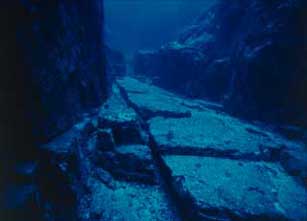
…
exclusive
…
June 2002
Morien Institute
illustrated interview with
Dr Paul Weinzweig
of Advanced Digital Communications,
Havana, Cuba, regarding
the discovery of:
“Megalithic urban ruins discovered off the coast of Cuba”
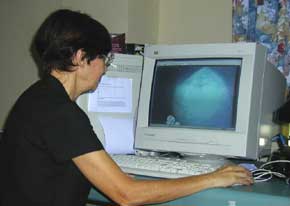
SeaLife
SL560 ReefMaster PRO
Set 35mm Camera
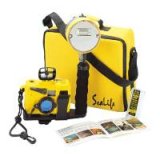
FEATURES:
Waterproof to 164 feet
35mm wide-angle lens
Triple-element lens construction
Push-button operation
Comes with SeaLife macro 3x close-up lens/underwater filter, SeaLife care kit, and external flash
“Atlantis of the West: The Case For Britain’s Drowned Megalithic Civilization”
by Paul Dunbavin
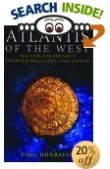
EU English Edition
“Do Welsh legends of lost cities beneath the sea match Plato’s descriptions of the island civilization of Atlantis? Do Irish myths of a golden age when the eastern Irish Sea was a flowery plain describe the same place Herodotus said disappeared beneath the waves during a single day and night of geological upheaval millennia before Ancient Greece?
Author and researcher Paul Dunbavin has embarked on a multidisciplinary investigation into how science could explain such a catastrophe and how modern archaeological findings point to a possible location for lost Atlantis. This book theorizes that the Middle Neolithic period around 5,000 years ago was a time of dramatic climate and sea-level changes all around the world.
From an up-to-date scientific perspective, Dunbavin distills an array of significant geological theories and then examines the archaeological and mythological record-which together leads to a lost land thousands of years ago in the Irish Sea that was still mentioned in ancient Welsh histories recorded in the 6th century.”
“Eden in the East: The Drowned Continent of Southeast Asia”
by Stephen Oppenheimer

EU English Edition
“A book that completetly changes the established and conventional view of prehistory by relocating the Lost Eden – the world’s 1st civilization – to SouthEast Asia. At the end of the Ice Age, SouthEast Asia formed a continent twice the size of India, which included Indochina, Malaysia, Indonesia and Borneo.
The South China Sea, the Gulf of Thailand and the Java sea, which were all dry, formed the connecting parts of the continent. Geologically, this half sunken continent is the Shunda shelf or Sundaland.
He produces evidence from ethnography, archaeology, oceanography, from creation stories, myths and sagas and from linguistics and DNA analysis, to argue that this founder civilization was destroyed by a catastrophic flood, caused by a rapid rise in the sea level at the end of the last ice age.”
“Discovery of Atlantis: Startling New Evidence and the Case for Cyprus”
by Robert Sarmast
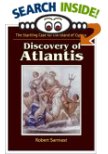
EU English Edition
“Plato provided 53 physical clues in his famous dialogue Critias–the original account of the story of Atlantis that is the sole basis of all Atlantis research.
Discovery of Atlantis proves that the island of Cyprus and the underwater landscape just south of Cyprus is a perfect match with 51 of these clues. Exclusive 3D bathymetric maps based on new scientific data show for the first time a stretch of sunken land off of Cyprus.
The general layout of the landscape of Atlantis as described by Plato is easily discernible on this underwater landmass, as well as the precise location of its capital–Atlantis City. This robust empirical data is joined with other original findings based on mythological analysis and historical research, making the case for Cyprus increasingly obvious.”
“Underworld: The Mysterious Origins of Civilization”
by Graham Hancock
&
Santha Faiia
(Photographer)

EU English Edition
“From Graham Hancock, bestselling author of Fingerprints of the Gods, comes a mesmerizing book that takes us on a captivating underwater voyage to find the ruins of a lost civilization that’s been hidden for thousands of years beneath the world’s oceans.
While Graham Hancock is no stranger to stirring up heated controversy among scientific experts, his books and television documentaries have intrigued millions of people around the world and influenced many to rethink their views about the origins of human civilization. Now he returns with an explosive new work of archaeological detection.
In Underworld, Hancock continues his remarkable quest underwater, where, according to almost a thousand ancient myths from every part of the globe, the ruins of a lost civilization, obliterated in a universal flood, are to be found.”
“Atlantis and Earth’s Shifting Crust”

VHS NTSC version
(USA and Canada)
“Searching for Lost Worlds: Atlantis”

VHS NTSC version
(USA and Canada)
“Quest for the Lost Civilisation: Boxed Set”

VHS NTSC version
(USA and Canada)
VHS UK PAL version
(UK and Europe)
“SeaLife ReefMaster DC310 Digital MAXX 3.3MP Digital Dive Camera”
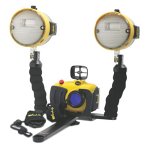
“The Atlantis Blueprint: Unlocking the Ancient Mysteries of a Long-Lost Civilization”
by Colin Wilson & Rand Flem-Ath

EU English Edition
“The Great Pyramid. Stonehenge. Machu Picchu. For centuries, these and other sacred sites have inspired wonder among those who ponder their origins.
Conventional science tells us they were constructed by local peoples working with the primitive tools of a fledgling civilization. Who could have built these elaborate monuments? How did they do it? And what were their incomprehensible efforts and sacrifices designed to accomplish? Now comes a revolutionary theory that connects these mysteries to reveal a hidden global pattern–the ancient work of an advanced civilization whose warnings of planetary cataclysm now reverberate across one hundred millennia.
International bestselling author Colin Wilson and Canadian researcher Rand Flem-Ath join forces to share startling evidence of a fiercely intelligent society dating back as much as 100,000 years–one that sailed the oceans of the world, building monuments to preserve and communicate its remarkable wisdom.”
“When the Sky Fell:
In Search of Atlantis”
by Rose & Rand Flem-Ath

EU English Edition
“Did Atlantis really exsist? If so,where was it,and what happened to it?
Inspired by the theory that at various stages in prehistory the earths crust shifted dramatically,causing violent earthquakes, tidal waves,devastating climatic changes,the authors examine the clues as to the location of Atlantis entrusted to Plato by Egyptian priests,the extraordinary similarities between myths from around the world,and ancient and amazingly accurate maps of South America and ice free Antarctica that date long before the first European explorers ever reached those shores.
They conclude that a civilization of highly intelligent seafarers did exists some twelve thousand years ago, but was destroy ed,by a geological disaster,leaving only a few survivors to safeguard its relicsand legends for posterity.”
“Atlantis, the Antediluvian World”
by Ignatius Donnelly
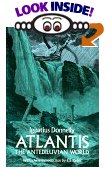
EU English Edition
“The most important book of its time (1882) on the subject of Atlantis.
The author claims there once existed in the Atlantic Ocean, opposite the mouth of the Mediterranean Sea, a large island, which was the remnant of an Atlantic continent, and known to the ancient world as Atlantis, that Atlantis was the region where man first rose from a state of barbarism to civilization, that the gods and goddesses of the ancient Greeks, the Phoenicians, the Hindus, and the Scandinavians were simply the kings, queens, and heroes of Atlantis, that the mythologies of Egypt and Peru represented the original religion of Atlantis, which was sun-worship, etc., etc. Illustrated with photographs.”
“The Round Towers
of Atlantis”
by Henry O’Brien

EU English Edition
“First published in 1834 as “The Round Towers of Ireland” or the “Mysteries of Freemasonry, of Sabaism, and of Budhism”, this book was an instant sensation as one of the first modern studies of Atlantis, round towers, pre-Christian megalithic architecture and secret societies.
In addition to being a sourcebook on Atlantis Research, Druidic Culture and origins of modern Celtic Christianity, the book is a treasure-trove of ancient esoteric lore and arcane knowledge of the past, including:
The History of the Tuath-de-Danaans, The Round Towers and Megalithic Crosses of Ireland are pre-Christian, Ireland’s strange connections with ancient India, Persia and China, Ancient Secret Societies and Ireland, Ancient Egyptians and Ireland, Pre-Christian Messiahs, Mithraism, and Ireland, The Connections Between Atlantis and Ireland.”
“Basic Decompression Theory and Application, Second Edition”
by Bruce R. Wienke
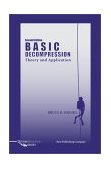
EU English Edition
“The new 2nd Edition of Basic Decompression Theory And Application has been extended, updated, with new material added. It takes all rudiments of decompression theory and phase mechanics to considerable depth, while focusing on diving applications in an historical perspective.
Topics span many disciplines, and the targeted audience is the commercial diver, hyperbaric scientist, doctor, physical scientist, technical diver, and instructor. Recent developments in diving tables, decompression meters, and decompression management software are presented, and broad model underpinnings are detailed and contrasted.
Testing and validation of modern dual phase approaches to staging for decompression, extended range, altitude, and mixed gas diving are a focus of discussion. Deep stops, optimal gas switches, and helium mixes are underscored from diver experience, data, and coarse grain principles. References and numerical examples (with solutions) are included for more detail and extended diver analysis.”
“Plato’s Timaeus”
by Peter Kalkavage (Translator)

EU English Edition
“A new translation in the Focus Philosophical Library series, with notes and introductory material, glossary and appendix.
Especially noteworthy are the extensive discussions in appendices on astronomy, geometry and music. Modern Students can now appreciate the wisdom of the world’s greatest thinkers.
Through clear, faithful translations, renowned scholars have made classical philosophical texts accessible and inspirational.”
“The Atlantis Dialogue: Plato’s Original Story of the Lost City, Continent, Empire”
by Plato, Aaron Shepard (Editor), B. Jowett (Translator)

EU English Edition
“Atlantis was first introduced to world literature by the Greek philosopher Plato in two “dialogues” he wrote in the fourth century B.C.
His tale of a great empire that sank beneath the waves has sparked thousands of years of debate over whether Atlantis really existed. But did Plato mean his tale as history, or just as a parable to help illustrate his philosophy?
In this book, you’ll find everything Plato said about Atlantis, in the context he intended. Now you can read and judge for yourself!”
“The New View over Atlantis”
by John F. Michell

EU English Edition
“The View Over Atlantis, John Michell’s unrivaled introduction to megalithic science, earth mysteries, and the inner meaning of number and measure, was described by Colin Wilson as ‘one of the great seminal books of our generation—a book which will be argued about for decades to come.’
Across much of the globe are ancient earthworks and stone monuments built for an unknown purpose. Their shared features suggest that they were originally part of a worldwide system, and John Michell argues that they served the elemental science of the archaic civilization that Plato referred to as Atlantis.
In this connection the most significant modern discovery is that of ‘leys’, the mysterious network of straight lines that link the ancient places of Britain and have their counterparts in China, Australia, South America, and elsewhere.”
“Successful Underwater Photography”
by Brian Skerry & Howard Hall
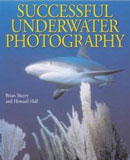
EU English Edition
“From fundamental principles of photographing marine life to making a living selling underwater photographs, Successful Underwater Photography provides an unlimited wealth of practical advice, surefire strategies, and tested tips for taking extraordinary photos of elusive underwater subjects.
Written by two top photographers who specialize in marine photography, this solid, lavishly illustrated field guide provides no-nonsense information on such topics as taking available-light photographs, silhouettes, marine wildlife portraits, close-focus wide angle photographs, and extension tube photographs to name just a few. Readers will also find proven guidance for purchasing underwater photographic equipment, taking photos of shipwrecks, and repairing and maintaining field equipment.
“Digital Imaging for the Underwater Photographer”
by Jack Drafhal & Sue Drafhal
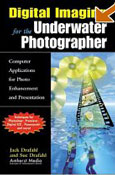
EU English Edition
“How to Solve Common Problems, Repair Images and Create Dazzling Presentations; Focusing on the aspects of digital imaging that are most important to underwater photographers, this book is a step-by-step guide for the professional and amateur alike to improve their images and presentations. Designed to help the underwater photographer make a smooth transition to digital imaging, this book discusses how to digitally refine, correct, and enhance underwater photographs. Detailing the equipment necessary, it also includes a discussion on the essentials of scanning. There is also extensive information on Adobe Photoshop, and how it can be used to edit underwater pictures.
Designed to help the underwater photographer make a smooth transition to digital imaging, this book discusses how to digitally refine, correct, and enhance underwater photographs. Detailing the equipment necessary, it also includes a discussion on the essentials of scanning. There is also extensive information on Adobe Photoshop, and how it can be used to edit underwater pictures.
SeaLife
DC310 3.3MP
Underwater Digital Camera

FEATURES:
Land Mode, Sea Mode and External Flash Mode
Instant delete option after each picture in both Sea and External Flash Modes
One-button operation
Expandable with all ReefMaster lenses, flashes and accessories
Depth tested to 200 ft / 60 m
“Maritime Archaeology: A Technical Handbook”
Jeremy Green
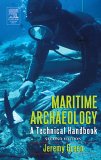
EU English Edition
“Jeremy Green’s systematic overview of maritime archaeology offers a step-by-step description of this fast-growing field. With new information about the use of computers and Global Positioning Systems, the second edition of this handbook shows how to extract as much information as possible from a site, how to record and document the data, and how to act ethically and responsibly wth the artifacts.
Treating underwater archaeology as a discipline, the book demonstrates how archaeologists, “looters,” academics, and governments interact and how the market for archaeological artifacts creates obstacles and opportunities for these groups. Well illustrated and comprehensive in its approach to the subject, this book provides an essential foundation for everybody interested in underwater environments, submerged land structures, and conditions created by sea level changes.
* Covers five broad areas: searching for sites, recording sites, excavation, management of collections, and study, research and publication.
* Describes a variety of techniques and procedures in considerable detail, accessible to both professional and amateur archaeologists.
* More than 250 photographs, charts, and diagrams explain everything from how to operate a sextant and a hand-held GPS to how a swim line should be laid out by the dive team before excavation begins.”
“From Atlantis to the Sphinx: Recovering the Lost Wisdom of the Ancient World”
by Colin Wilson

EU English Edition
“Wilson’s bestseller explores the mysteries of the pyramids and how they were built by a highly advanced archaic civilization.
Recent discoveries of ancient water damage to the Sphinx have thrown the scientific world into a tizzy with the suggestion that Egypt’s legendary monuments might be thousands of years older than previously believed. In his astonishing new bestseller, Colin Wilson delves into these explosive new findings and takes us on a grand tour of the knowledge amassed by researchers over the centuries.
He explores mysteries that have puzzled humanity since Plato: Was there an ancient civilization, destroyed by a great catastrophe, whose survivors built the Sphinx some 10,500 years before Christ? Did they possess a knowledge system that could orchestrate the transport of stones weighing thousands of tons, an accomplishment that still baffles modern engineers?”
“Noah’s Flood: The New Scientific Discoveries About the
Event That Changed History”
William B. F. Ryan, Walter C. Pitman, William Haxby (Illustrator)

EU English Edition
“For thousands of years, the legend of a great flood has endured in the biblical story of Noah and in such Middle Eastern myths as the epic of Gilgamesh.
Few believed that such a catastrophic deluge had actually occurred. But now two distinguished geophysicists have discovered an event that changed history, a sensational flood 7,600 years ago in what is today the Black Sea. Ancient clay tablets excavated from the ruins of biblical Nineveh more than a hundred years ago revealed a much older version of the same flood legend. Archaeologists searched the length and breadth of the Tigris and Euphrates rivers in Mesopotamia for evidence of such a flood, to no avail.
Then, as earth scientists made new discoveries about the history of rapid climate change, they learned that the Mediterranean had once been a desert and that five million years ago, the Atlantic Ocean burst through the Strait of Gibraltar and refilled the Mediterranean basin.”
“Gateway to Atlantis: The Search for the Source of a Lost Civilization”
by
Andrew Collins & David Rohl (Introduction)
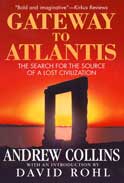
EU English Edition
“A historian’s investigation that may have solved one of humankind’s greatest and most enduring mysteries: the location of the ‘Lost City’ of Atlantis.
More than 2,350 years ago Plato wrote of the fabulous island empire of Atlantis, which ruled the ocean as well as parts of the ‘opposite continent’ – what we know today as the Americas – until the single ‘terrible day and night’ that destroyed it in a storm of earthquakes and floods. And now, after years of travel and research, Andrew Collins has gathered convincing evidence that may establish not only that Atlantis did indeed exist but also that remnants of it survive today.
Collins’s journey into the past follows the clues left by Plato, and they take him far beyond Crete and the Mediterranean, where scholars in recent times have located Atlantis. So do mummies in Egypt, Roman wreckage in the West Atlantic, the African features of great stone heads in Mexico, and the explosion of a comet 10,500 years ago.”
“Maps of the Ancient Sea Kings: Evidence of Advanced Civilization in the Ice Age”
by Charles H. Hapgood
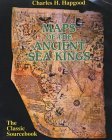
EU English Edition
“Charles Hapgood’s classic book on ancient maps produces evidence of an advanced world-wide civilization existing many thousands of years before ancient Egypt.
He has found the evidence in the Piri Reis Map that shows Antarctica, the Hadji Ahmed map, the Oronteus Finaeus and other amazing maps. Hapgood concluded that these maps were made from more ancient maps from the various ancient archives around the world, now lost.
Not only were these unknown people more advanced in mapmaking than any other prior to the 18th century, it appears they mapped all the continents. The Americas were mapped thousands of years before Columbus and Antarctica was mapped once its coasts were free of ice.”
“Atlantis and Lemuria: The Lost Civilizations in the Light of Modern Discoveries”
by
Frank Joseph

EU English Edition
“Charles Hapgood’s classic book on ancient maps produces evidence of an advanced world-wide civilization existing many thousands of years before ancient Egypt.
He has found the evidence in the Piri Reis Map that shows Antarctica, the Hadji Ahmed map, the Oronteus Finaeus and other amazing maps. Hapgood concluded that these maps were made from more ancient maps from the various ancient archives around the world, now lost.
Not only were these unknown people more advanced in mapmaking than any other prior to the 18th century, it appears they mapped all the continents. The Americas were mapped thousands of years before Columbus and Antarctica was mapped once its coasts were free of ice.”
|




































